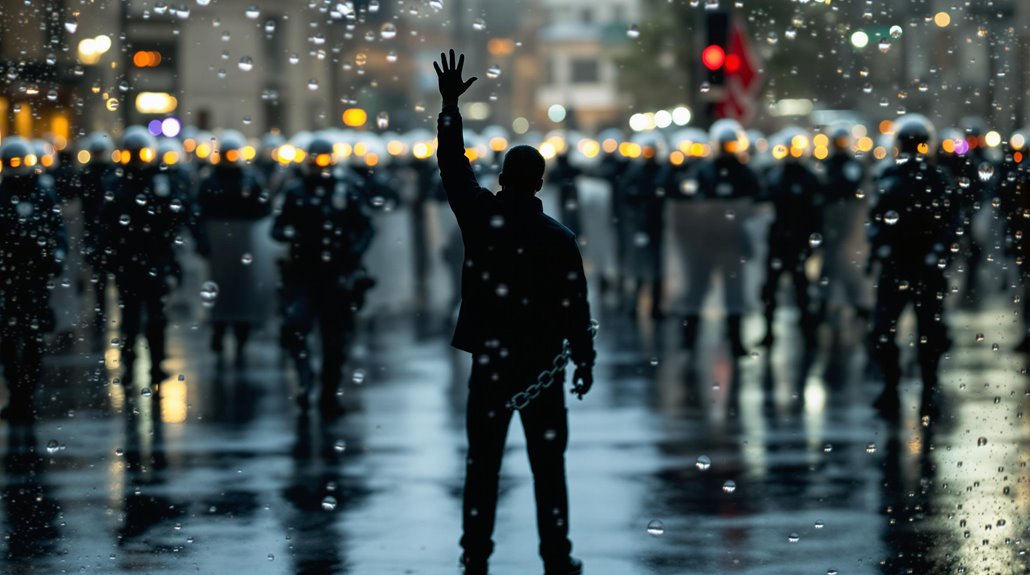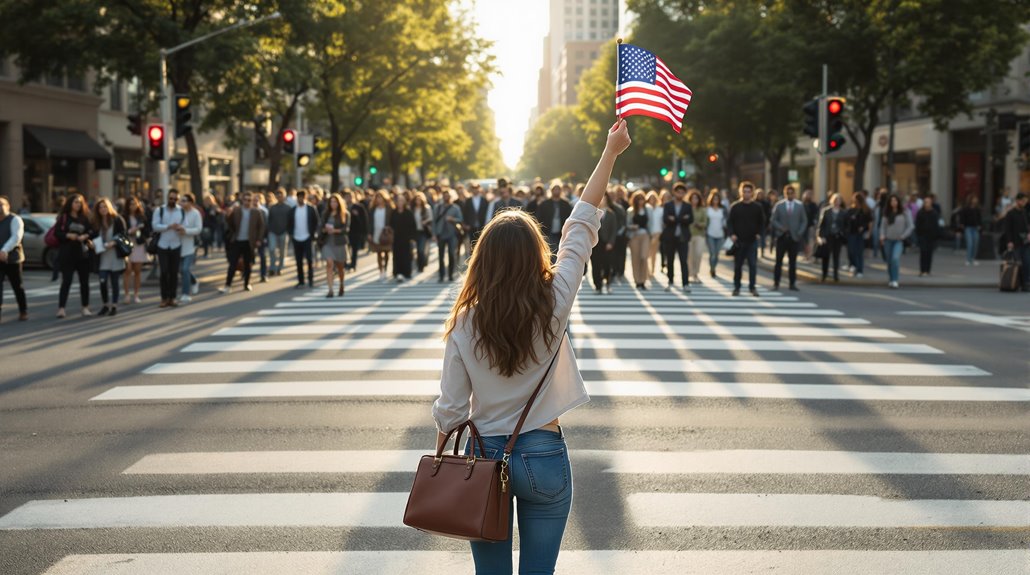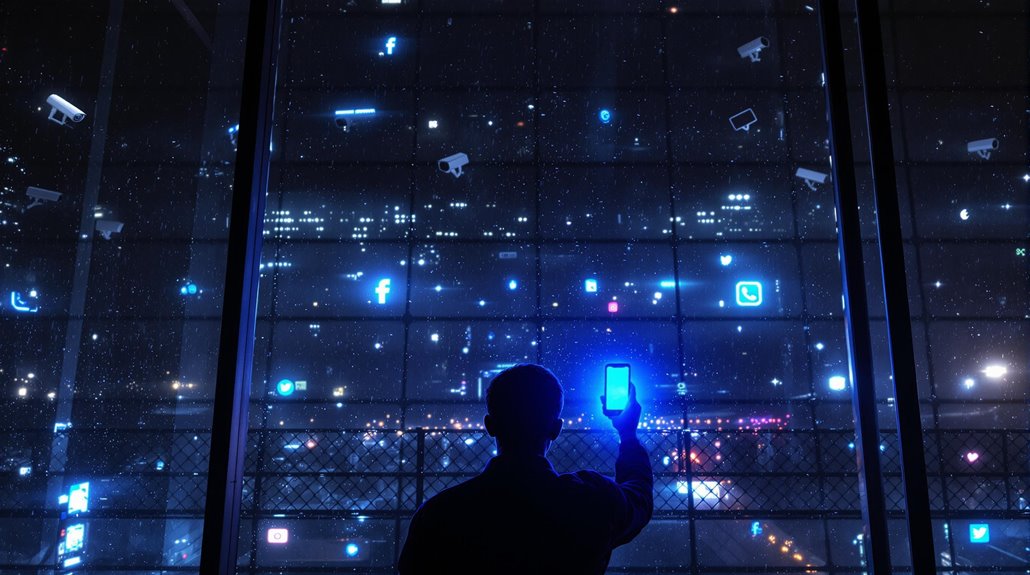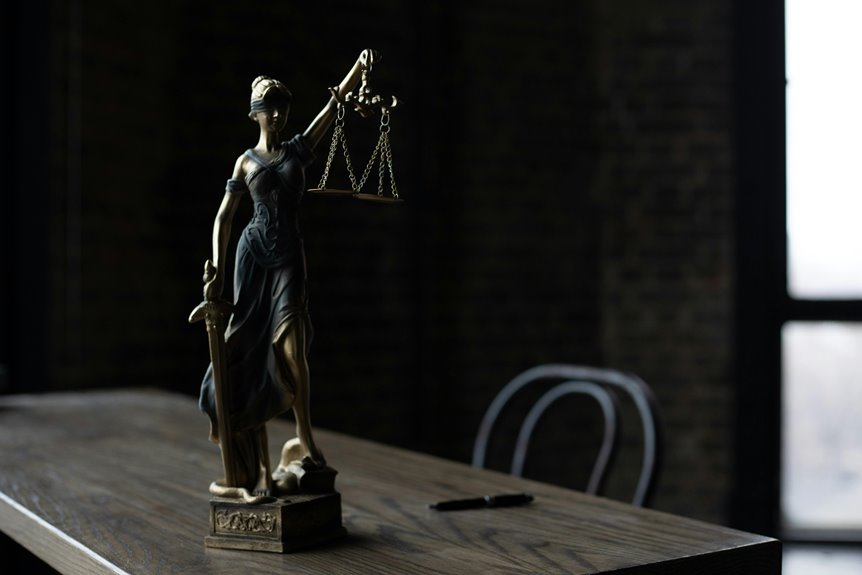You’re witnessing a constant tug-of-war between personal freedoms and social stability in today’s hyperconnected world. Liberty and order represent opposing yet complementary forces that shape modern society, with governments acting as both guardian and referee. While individual rights remain paramount, they must coexist with collective needs for safety and security. Recent challenges like digital surveillance and religious restrictions highlight this delicate balance, revealing deeper complexities beneath the surface of civic life.
The Historical Tension Between Freedom and Security

Throughout history, nations have wrestled with a fundamental dilemma that shapes their very foundations. You’ll find this tension embedded in every major historical conflict, from ancient Rome’s rise to modern democracies.
When you examine freedom struggles across centuries, you’ll notice a recurring pattern: societies swing like pendulums between liberty and control.
Consider how you’re experiencing this age-old balance today. Your government’s power to protect you often comes at the cost of your personal freedoms.
During times of crisis, you’ll see authorities expand their reach – surveillance increases, regulations tighten, and individual rights face new limits. It’s the same story that played out during the Cold War, post-9/11, and now in our digital age.
Your security and your liberty remain locked in an endless dance of compromise.
Defining Liberty in Modern Society
Liberty’s definition has morphed dramatically in our hyperconnected era.
You’ll find that individual autonomy now intersects with social responsibility in ways your grandparents couldn’t have imagined. Your personal freedoms are constantly weighed against collective welfare, creating a complex dance of rights and obligations.
You’re witnessing how civic engagement has evolved beyond traditional voting and protests.
Today’s democratic participation demands digital literacy, cross-cultural understanding, and respect for ethical boundaries. Your liberty isn’t just about what you can do – it’s about how your actions impact an increasingly interconnected society.
Cultural diversity has transformed from a buzzword into a critical component of modern liberty.
You’re no longer just a citizen of your local community; you’re a participant in a global conversation about what freedom means in the 21st century.
Understanding Social Order and Its Importance
Social order stands as the bedrock of any functioning society, yet it’s dangerously misunderstood in today’s fragmented landscape.
You’ll find that social cohesion and community trust aren’t just feel-good concepts – they’re measurable indicators of public safety and economic stability. When local governance breaks down, you’re left with fractured neighborhoods and declining civic engagement.
You can’t separate social norms from cultural diversity in modern communities. They’re interconnected elements that shape how you experience equitable access to resources and opportunities.
The data shows that communities with strong conflict resolution mechanisms and restorative justice programs report 40% fewer incidents of social unrest.
Your role in maintaining social order isn’t passive – it requires active participation in building bridges between different community segments to guarantee lasting stability.
Key Principles of Balancing Individual Rights With Collective Needs

When balancing individual freedoms against collective welfare, you’re maneuvering a complex web of competing interests and constitutional obligations. Your individual autonomy must coexist with collective responsibility, creating inevitable ethical dilemmas that shape societal expectations.
- Legal frameworks establish boundaries between personal rights and public good
- Cultural values influence how communities interpret and apply these boundaries
- Public discourse shapes the evolution of social contracts and civic engagement
- Practical implementation requires constant adjustment to changing circumstances
- Economic impacts must be weighed against social benefits
You’ll find that successful balance hinges on understanding how these elements interact. The key lies in recognizing that individual liberty doesn’t exist in isolation – it’s bound by the fabric of shared responsibility.
Through structured civic engagement, you can help create solutions that preserve personal freedom while honoring collective needs.
The Role of Government in Maintaining Equilibrium
Through decades of constitutional precedent and legislative evolution, government’s essential role emerges as both guardian and referee in the delicate balance between individual rights and societal stability. You’ll find this equilibrium reflected in how modern democracies structure their oversight mechanisms.
| Government Function | Impact on Balance |
|---|---|
| Law Enforcement | Protects rights while maintaining order |
| Judicial Review | Guarantees constitutional compliance |
| Legislative Action | Creates framework for civic engagement |
| Executive Oversight | Implements balanced policies |
| Public Services | Supports collective needs |
You’re witnessing this balance play out daily through government accountability measures that shape your freedoms. When officials enforce regulations while protecting individual liberties, they’re performing a complex dance that requires constant adjustment. It’s a system that depends on your active civic engagement to maintain its effectiveness and prevent overreach.
Case Studies: When Liberty and Order Clash
You’ll find that every major societal clash between liberty and order follows a predictable pattern, from civil rights protests met with aggressive police responses to religious gatherings restricted during public health emergencies.
When examining historical cases, security measures like surveillance programs and protest restrictions consistently reveal government’s tendency to favor order over individual freedoms, often at the expense of constitutional rights.
Your fundamental civil liberties—freedom of assembly, religion, and speech—remain perpetually under siege through a systematic pattern of overreach that officials conveniently justify as “necessary for public safety.”
Civil Rights Vs Security
Over the past two decades, civil rights and national security have engaged in an escalating tug-of-war that’s transformed America’s social landscape.
You’ve witnessed unprecedented emergency powers emerge while privacy concerns mount. The challenge of balancing rights with public safety has created deep social divisions, particularly in community policing and civil unrest responses.
- NSA surveillance programs capture 534 million phone records annually
- 67% of Americans support facial recognition for enhanced security
- Constitutional limits face constant testing through executive orders
- Social justice movements report 48% increase in privacy violations
- Local police departments now employ military-grade equipment
You’re living in an era where your civil liberties face daily compromise in the name of national security.
The trade-offs aren’t always clear, but the impacts are profound. From airport screening to digital surveillance, you’re maneuvering through a new normal that demands constant vigilance.
Protests and Police Response
As protests sweep across major American cities, the collision between civil liberties and law enforcement reveals stark patterns of escalating force.
You’ll witness protest tactics evolving from peaceful demonstrations to strategic disruptions, while police departments grapple with maintaining order through controversial crowd control methods.
When you examine police accountability measures, you’ll find a troubling gap between policy and practice.
Body cameras malfunction at critical moments, incident reports go unfiled, and community engagement initiatives fade into PR exercises.
Your rights during civil disobedience aren’t always protected – tear gas canisters fly before warnings are given, and peaceful protesters face aggressive dispersal tactics alongside violent agitators.
The data shows a 43% increase in use-of-force incidents during demonstrations since 2019, while civilian oversight boards struggle to keep pace with mounting complaints.
Religious Freedom Restrictions
While the First Amendment enshrines religious freedom as a fundamental right, recent government restrictions have sparked constitutional crises nationwide.
You’ll find that faith-based policies increasingly clash with societal values, creating ethical dilemmas for communities trying to balance spiritual expression with church-state separation.
- Local zoning laws blocking new mosque construction despite documented community engagement
- School districts banning religious clothing and symbols in classrooms
- Healthcare mandates conflicting with religious organizations’ belief systems
- Workplace restrictions on prayer times and religious accommodations
- Public funding denials for faith-based community service programs
You’re witnessing an unprecedented tension between religious tolerance and regulatory oversight.
When government agencies implement restrictions citing public safety or secular interests, they’re often met with legal challenges that test the boundaries of constitutional protections.
This complex interplay demands careful consideration of competing rights.
Technology’s Impact on Freedom and Security

Since the dawn of digital innovation, technology has fundamentally transformed our relationship with personal freedom and national security. You’ll find yourself traversing an increasingly complex landscape where digital surveillance tracks your every move, while cybersecurity threats loom larger each day. Your data ownership rights often conflict with corporate interests and government monitoring programs.
| Impact Area | Freedom Effects | Security Effects |
|---|---|---|
| Social Media | Speech amplification | Misinformation risks |
| AI Systems | Personalization | Algorithmic bias |
| Encryption | Privacy protection | Criminal concealment |
You’re witnessing an unprecedented shift in how technology shapes civil liberties. Your online freedom now depends on understanding encryption debates, while AI ethics challenge traditional notions of privacy. The technological empowerment you’ve gained comes with a steep price: your digital footprint is forever subject to scrutiny, analysis, and potential exploitation.
Creating Sustainable Solutions for Tomorrow’s Challenges
You’ll find that today’s green innovation strategies move far beyond recycling bins and LED bulbs, reaching into AI-powered smart grids and regenerative architecture that transforms how cities breathe and function.
Your local community’s resilience depends on implementing these solutions strategically, from microgrids that keep power flowing during disasters to urban farming initiatives that strengthen food security.
When you examine the intersection of technological advancement and community-based sustainability efforts, you’re looking at the blueprint for surviving the unprecedented environmental challenges that threaten our collective future.
Green Innovation Strategies
As global temperatures continue to shatter records, innovative green technologies emerge as our vital lifeline for planetary survival.
You’ll find that sustainable practices and eco-friendly innovations are reshaping how businesses approach climate solutions. Through green entrepreneurship and circular economy models, you’re witnessing a transformation in environmental policies.
- Smart grid systems that optimize renewable energy distribution
- Biodegradable packaging materials derived from mushroom mycelium
- Carbon capture technologies integrated into existing infrastructure
- Zero-waste manufacturing processes using AI optimization
- Vertical farming solutions for urban food security
You’re now at a vital intersection where green technology meets economic viability.
Building Resilient Communities
While natural disasters and economic shocks continue to threaten communities worldwide, the path toward resilience demands immediate, strategic action.
You’ll need to invest in both physical infrastructure and social cohesion to protect your neighborhood from mounting challenges.
Community resilience starts with understanding your local vulnerabilities. You must assess your area’s specific risks, from flooding to economic downturns, and develop targeted response plans.
Build networks of mutual support through neighborhood associations, emergency response teams, and shared resources. Your community’s strength lies in these connections.
You can’t rely solely on government intervention when crisis strikes. By establishing local food systems, renewable energy projects, and disaster preparedness programs, you’re creating layers of protection.
These initiatives don’t just safeguard against threats – they build the social fabric that keeps communities thriving through any challenge.
Conclusion
You’re walking a tightrope between liberty and order in today’s hyperconnected world, where one person’s freedom fighter is another’s chaos agent. Like a medieval knight trying to navigate rush hour traffic, you must adapt ancient principles to modern challenges. The solution lies in your commitment to uphold both individual rights and collective stability, through transparent governance, technological safeguards, and active civic participation. The future demands nothing less than this delicate balance.





